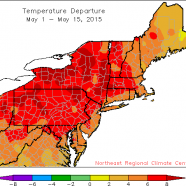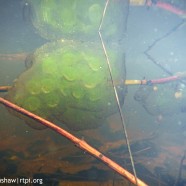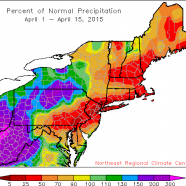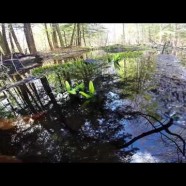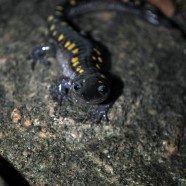Scorching May
The first half of the month of May 2015 was a quietly scorching one, with the heat turned all the way up in the Northeast. You may not believe it based on the outdoor feel of our day to day weather, but the entire region was far warmer than usual. While we did not have the extreme highs or actual heat waves, a stretch or days well into the 90s or anything particularly memorable, we have been consistently warmer than average for our highs and often above the long-term lows. The Northeast Regional Climate Center map here shows us the tale. The coolest part has been sections of Maine which were...
Read MoreBouncing Babies
Here we have some bouncing baby…umm, boys and girls I would guess. These spotted salamander (Ambystoma maculatum) babies will soon be hatching from their globular masses and become veracious predators in the little vernal pools in which they temporarily reside. As they feed and grow, they will be racing against the clock in order to develop from free swimming legless tadpoles into four legged land dwellers before their nursery pool dries out towards the end of the summer. Talk about rapid development! Elyse Henshaw Conservation Technician
Read MoreTale of Two April Climates
The first half of April 2015 was a Tale of Two Climates: when compared to long-term averages, New England was cool to cold and dry, sometimes exceptionally so, while the Mid-Atlantic was warm and wet, sometimes ridiculously so. Fortunately since then it has balanced out to some degree (pun intended) and conditions have moderated in both regards. In my opinion we seem to be at a relatively average place in terms of “green out”, with buds and leaves near where they “should” be for our returning birds and emerging insects. Scott Kruitbosch Conservation & Outreach...
Read MoreProductive Vernal Pools
Have you ever wondered what might be hiding just beneath the water’s surface in these temporary pools that crop up in early spring? This little clip reveals a productive vernal pool that has a number of spotted salamander (Ambystoma maculatum) egg masses nestled within the leaf litter of the pool floor. These pools are an important breeding area for several amphibian species, as you can see, because they provide a safe fish-less environment for the eggs and eventual tadpoles to...
Read MoreSpring Migrations Have Begun!
So I’ve got a bit of a funny story for you and it goes a little something like this: last Thursday night, as we suspected, warm overnight rains began to draw spotted salamanders (Ambystoma maculatum), spring peepers (Pseudacris crucifer), and other amphibians out from their winter refuges. They began their journeys to nearby vernal pools, but some of them took detours in the process. My husband Tyler and I were house and pet sitting for my parents while they were on vacation. Behind their home is a series of ponds that make up a beautiful wetland system, and vernal pools are abundant...
Read More



